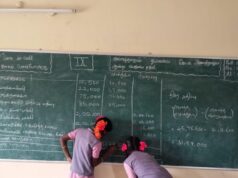Indian education policy space might not have seen a report as progressive as “The Report of the Review Committee on the Delhi school Education Act and Rules, 1973”, thanks to former Chief Secretary of Delhi, Shailaja Chandra, IAS (retd.), the chairperson of the drafting committee of this three volume report.
The review committee has consulted more than 100 people from education directorate, non-governmental organizations, MCD, DDA, NIC, legal fraternity, parent’s association, SCERT, various principals and teachers of private and government schools, private school associations, and various eminent educationists to compile the report. Though this report reviews Delhi School Education Act, 1973, its commentary on legal cases related to education, references from various national committees on education, use of empirical data on different types of schools and learning outcome data from ASER (Pratham) makes this report very robust and applicable to all the states in India.
I will quote some excerpts from the report to highlight some of the salient feature of the report:
Companies should be allowed to venture into the education sector (page 77, volume I)
“……The Committee feels that prima-facie it would be a good idea to promote an alternative which precludes commercialization but brings in private resources….”
“…Presently many private schools are being run as family conglomerates. Almost all the key posts in the Management are held by family members and a large part of the income from the school goes back to the concerned family. If Companies are allowed to venture into the education sector, the possibility of exploiting employees would be reduced because a company does not serve the interests of a single person/ family………..It would reduce the gap between demand and supply and promote competition…….”
Recognition for unrecognized budget performing schools (Page 76, Volume-I)
The report is one of the very few reports which delve on the importance of unrecognized schools in the city, which are also known as budget private schools or affordable private schools. The review report quotes that as per the Association of Unrecognized Schools there are more than 4000 schools in the primary sector which are running without recognition and as per the MCD survey report there are 1593 unrecognized schools in Delhi. It further states that, if Delhi master plan 2021 (effective from 07.02.2007) stipulates 800 sq. meters land for a primary school are applied than a mere 16% would qualify for recognition. However, if MCD applies old land norms of 200 sq. meters then 61% of unrecognized schools would qualify for recognition.
“…..The Review Committee is of the opinion that as long as the basic requirements spelt out by RTE ‘09 are met and the norms for teacher’s qualifications are fulfilled maximum number of schools should be considered for recognition. A study done by PRATHAM an NGO in the Education sector has revealed that the educational outcomes of private schools running in one of the most disadvantaged wards of the city Nandnagri were superior to that of the MCD schools and even the Delhi Government schools….”
This is probably one of the only reports in the government domain, which acknowledges that budget private schools are performing better than the government and municipal run schools.
Lack of autonomy lead to the decline of Aided schools? (page 35, volume I)
“……..The Delhi School Education Act and Rules 1973 made a distinction between Government Schools and Government-Aided Schools and Unaided Private Schools. As a result of this, the Managing Committees of aided schools lost the autonomy they once enjoyed. This reduced their control over the staff because of a newly-granted “security of service” which devolved on the teachers. …….. This reduced the chances of recruiting specially identified Principals and teachers who could maintain the high standards for which the schools had once received acclaim…….”
Remove Essentiality Certificate (page 78, volume I)
The Review Committee examined the provisions of Rule 44 of the DSEAR ‘73. This provision was made initially to enable the Directorate to assess the requirement of schools in a particular zone before opening of the new school as the land was allotted to the societies to run a school through DDA. ……… There is already scarcity of nazul land in Delhi. By restricting the supply of schools in an area, the Directorate restricts the role of the market in assessing the demand for school education. ………. There is no such provision under the RTE ‘09; it stipulates that no school shall run without recognition. Therefore, in the opinion of the Review Committee the provision of Essentiality Certificate contained in Rule 44 may be deleted and it should be left open to the market to decide the requirement of schools in a particular area.
Salary of teachers for low fee schools (page 98, volume I)
“……The expectation that all schools can uniformly pay government scales to the teachers is being unrealistic. The Review committee recommends that the teachers’ salaries should have some relationship to the school fees in the case of smaller schools. A bench mark could be that 50% of the fee collection would have to go towards teachers’ salaries. 40% teachers may be allowed to be taken on contract basis except for core subjects. Both these measures may bring some realism into what has become a game of charades……”
Post Disclaimer
The opinions expressed in this essay are those of the authors. They do not purport to reflect the opinions or views of CCS.





